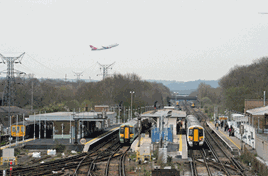“And at the couple of hundred stations that are not in the core, we’ve had to deploy new ramps to get wheelchair passengers on and off. And, of course, they have to be located next to the two specific carriages - because if people get on the wrong carriage outside London, they would then be unable to get off in the core.”
For nearly a year, Thameslink has been recruiting and training staff ready for the new trains. Initially they will work from Siemens’ state-of-the-art Three Bridges depot.
“We call the depot operators our ‘train doctors’,” explains Dyan Crowther, chief operating officer of the Govia Thameslink Railway franchise, which from July 26 formally incorporated the Southern and Gatwick Express brands alongside Thameslink and Great Northern.
“We have new ways of working, new operating standards,” she says. “This is a very intelligent train, very technical. So there is a lot of testing and commissioning.
“We have more than 100 drivers in training. We had the biggest recruitment campaign ever for drivers. We didn’t have enough spare to carry out all the testing, and we have doubled the number of driver trainers, too.
“We needed enough drivers on the existing trains, so we could take them all out in turn for the conversion course. The test drivers have already been out to Germany. They are now ready for the arrival here.
“Initially we will look after this train like a newborn baby. We will have numerous staff on board during the testing, which will all be in the dead of night. We have to do high-speed pantograph tests, ride and stability tests, and door tests. And we have to make sure all the passenger information systems work. We have to achieve a set amount of fault-free running before each train gets its certification.”
NR’s Curtis adds: “These will be the first new trains on the main line ready for ETCS signalling, all fitted and commissioned.
“We are starting that testing in the core using an old Class 313 at night. When it works on the old train we will test the new trains with it - probably September. And we have to test the Automatic Train Operation. We won’t be using it at first, but when we go to 24 trains per hour in 2018, it will rely on ATO being in place.”
The route has had many new trains in recent years. As First Capital Connect, the Thameslink service was steadily upgraded. But the incoming trains were all known quantities, derivatives of the Bombardier-built Electrostar. The Siemens order is a brand new fleet incorporating brand new technology. And it is very different in scale - the largest train order ever placed in the UK.
“Then we will have the new Gatwick Express trains in 2016,” adds Curtis. “They are more Class 387s with different interiors, so they will be less challenging. But there are power implications, because they are replacing the old Class 442s, so we still need further assessments on the power draw to make sure there will be enough volts in the third rail.”
Crowther notes that a fleet of ‘387s’ has already been introduced for Thameslink.
“They replaced all the Bedford to Brighton Class 319s, which was done without a murmur. It went well,” she says.
“But the ‘700’ is a new class of train, so there is a lot more rigour with this. That means looking at the whole thing as a system - us, Siemens and Network Rail all working together. We have to be supportive and collaborative.”
Crowther oversees what has just become Britain’s biggest passenger franchise. Below her are five passenger service directors covering Thameslink, Great Northern, Gatwick Express, Southern Metro, and Southern Mainline & Coast. She says each is “like a mini managing director”.
The challenge is considerable. Never before has Britain introduced a completely new fleet on this scale or with this complexity, while mixing it with Automatic Train Operation and ETCS signalling.
“That’s why I joined the business,” enthuses Crowther. “This is a transformational process.”
The new trains can carry up to 1,700 people. The existing trains carry 1,200 passengers in 12-car formation, although many are currently eight-car. As well as enabling a huge increase in numbers, from 2018 the fleet will serve new routes such as Cambridge to Gatwick. There will also be a link with Crossrail.
The cascade of new trains for old will require detailed management. It is simply not possible to take delivery of a whole new fleet and put it into service in one go - there is nowhere to stable that number of additional, longer trains. There are new sidings at Three Bridges, but not enough to manage the changeover alone.
“It’s not quite a case of one new train in, one old one out. But we have a finite amount of space to keep them. It is a very complex process,” says Crowther.
Over the next three years there will be a gradual building up of pressure before the key timetable change in December 2018. That’s the deadline for all the Siemens trains to be delivered, tested and in service. It’s when Network Rail will have to handle 24 trains an hour through the core, using Automatic Train Operation.
“It’s only three and a half years away, so planning started long ago,” says Curtis.
“However, in its franchise bid, GTR proposed the whole timetable framework would come in this December instead. Not at the full 24 trains per hour, but the Brighton Main Line and Midland Main Line will already have the structure in place. So we have to be Class 700-ready. As the trains are delivered they can then just slot in, in place of existing trains.”














Comment as guest
Comments
No comments have been made yet.